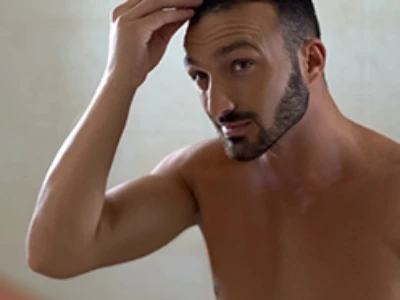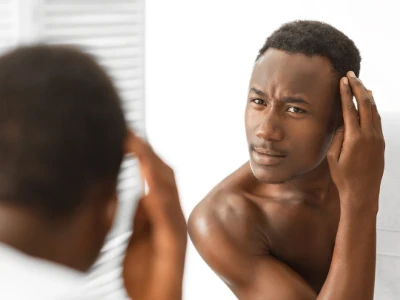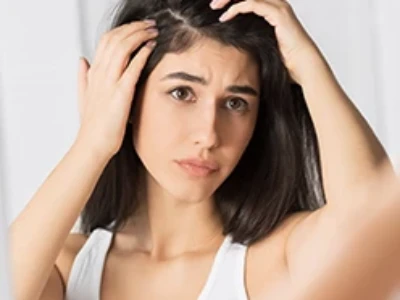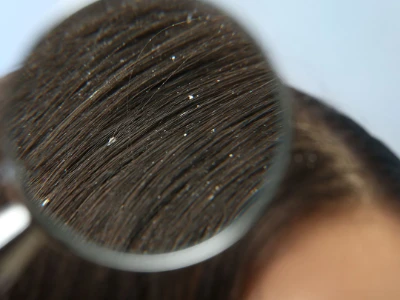Dandruff shampoo for men and women: can we use the same anti-dandruff shampoo?
2:30 MINUTE READ TIME

Introduction
Nothing can feel more embarrassing than dandruff peppered around your head, scalp and shoulders. Dandruff is not a gender-specific problem; however, research does show men are more susceptible to developing dandruff issues than women. This might spark some questions in your mind, such as what is the biological difference in scalps? Why do some brands offer genderspecific anti-dandruff shampoos? And does it make any difference?
You’ll find the answers to all these questions and how to find the right product for you in this article. Let’s get started.
What are the differences between men's and women’s scalps?
Scalp conditions like dandruff vary from person to person, depending on age, environment, and gender. Women might face dandruff issues because of hormone fluctuations, while men are more likely to develop dandruff due to protein loss and high sebum production.[1]
While there is not much information published about the scalp difference between genders, we have reviewed research data that explains how the scalp skin of women is different from that of men.
The difference is primarily based on protein production, amount of sebum, composition, and skin barrier function. These can all lead to minor scalp skin differences between men and women. Therefore, some brands offer gender-specific anti-dandruff shampoos.[1]
However, before we move to that point, let’s first learn about the differences between the scalp skin of men and women.
1. Sebum amount
Did you know that men's scalps are 1.5 times oilier than women’s? This is another reason why men are more prone to dandruff, and why sebum accumulating around your scalp can lead to dandruff.[2]
As soon as you hit puberty, your sebaceous glands start actively secreting sebum. The sebum secretion rate stays high from around 15 to 35 years old. As you age beyond 35 years old, sebum production slows down[3]. In women, sebum secretion gets increasingly slower after the menopause.[4]
Throughout this period of sebum secreting activity, production rates in men remain higher than in women. This contributes to the disproportionate amount of scalp flaking disorders and skin irritation between men and women.[5]
2. Sebum composition
Men naturally have a higher percentage of heavy materials like triglycerides and cholesterol esters in their sebum. Contrarily, women's sebum has a higher percentage of volatile and lighter components like fatty acids. Such sebum composition differences between men and women affect scalp skin conditions.[1]
3. Protein loss
One of the primary differences is that the loss of protein in men is higher. A study in 2017 found that men experience more protein loss from their scalp than women. As a result, they have a higher chance of developing dandruff, which alongside increased sebum production can lead to hair loss.
Since men experience more protein loss and sebum secretion, they may need to pay more attention to their scalp care to prevent hair loss and dandruff.[1]
4. Skin barrier function
The stratum corneum (SC) is your skin's outermost layer, which protects your skin and helps retain its moisture. In men’s scalps, the SC’s levels of ceramide are lower. This can cause a weakening and reduced function of the skin barrier. Therefore, surfactants can more easily penetrate the epidermal layer and damage the skin proteins.[1,3]
Weaker skin barrier functions can lead to various skin problems, like dandruff, men’s dry scalps and skin, skin sensitivity, and itchiness. It means men are at a higher risk of developing itchy, flaky, and or oily scalps. Comparatively, women’s scalp barriers are stronger, so they are less likely to have these issues.[2]

Can men and women use the same anti-dandruff shampoos?
Now you know the subtle scalp skin differences, you must be wondering if men and women can use the same anti-dandruff shampoo.
All the anti-dandruff shampoos are formulated with active ingredients like selenium sulfide and coal tar. Both these ingredients have antifungal properties. Selenium sulfide helps manage natural oil production to keep dandruff at bay, whereas coal tar keeps skin cell production under control. (Coal tar can lighten your hair color, so you might want to avoid products with it if you have light hair.) Another ingredient commonly found in antifungal shampoos is pyrithione zinc, which prevents dandruff by stopping yeast growth on the scalp.[5]
You may see anti-dandruff shampoo for women and separate products on how to get rid of dandruff for men. Seeing that all anti-dandruff shampoos have similar ingredients, they are not genderspecific and anyone with dandruff can use them.
Not every anti-dandruff shampoo is going to work for you. With that in mind, evaluate your dandruff symptoms and hair type so you use a product that best suits your needs. Ultimately, pick a shampoo that will soothe your itchy scalp, strengthen your hair, and clear your scalp of dandruff.
Selsun blue® has a range of products that can be used by all genders. To find an anti-dandruff shampoo for your individual needs, explore our products page.
What are other options for men and women to get rid of dandruff?
Apart from using anti-dandruff shampoos, there are several different ways you can relieve dandruff symptoms. It begins with taking good care of your hair and skin. Managing your lifestyle and routine all assist in keeping your scalp healthy.
Let’s take a look at some dos and don’ts you can adopt to improve your scalp health and prevent dandruff.
Do
-
Keep your scalp skin clean: Regularly washing your hair and scalp keeps it clean and healthy.[6]
-
Follow a hair and scalp care routine: It is important to establish a hair and scalp care routine based on your skin and hair type. For instance, people with an oily scalp should shampoo every day to keep it clean.[6,7]
-
Stress management: Stress triggers skin conditions like dandruff, seborrheic dermatitis, psoriasis, and eczema. Engaging in stress-relieving activities can help manage the symptoms and keep such conditions at bay. Meditate, exercise, or indulge in your favorite hobbies to reduce your stress levels.[7]
Don't
-
Use hairstyling products excessively: Avoid using hairstyling products frequently, especially when you are trying to eliminate dandruff (men and women). These styling products include hair sprays, gels, and styling creams. Excessive use of such products can damage a sensitive scalp and aggravate the condition. Be wary of procedures, such as hair straightening, that often require highly chemical products: These can trigger conditions like dandruff and hair loss.[6]
-
Use products containing alcohol: Using hair products that have alcohol in them can make dandruff worse as they dry out your skin. To avoid a dry scalp, shampoo for men and women should be alcohol-free.[6]
Conclusion
Regardless of gender, you can control dandruff using the same shampoos. Even though research shows that male scalps differ slightly from women's, it all comes down to how you maintain your individual scalp hygiene and what kind of products you use to control dandruff. Anti-dandruff products are usually formulated with similar ingredients, so they don't have to be gender-specific. Man or woman, you can go dandruff-free and maintain a healthy scalp by following the suggestions and guidelines in this article. Take care of your hair and skin, so you can look your best any day.
References
-
(PDF) Gender differences in scalp health (2022). Available at: https://www.researchgate.net/publication/280933476_Gender_differences_in_scalp_health (Accessed: 28 February 2022).
-
Kim, S. et al. (2021) "Understanding the Characteristics of the Scalp for Developing Scalp Care Products", Journal of Cosmetics, Dermatological Sciences and Applications, 11(03), pp. 204-216. doi: 10.4236/jcdsa.2021.113018.
-
Xu, Z. et al. (2016) "Dandruff is associated with the conjoined interactions between host and microorganisms", Scientific Reports, 6(1). doi: 10.1038/srep24877.
-
Borda and wikramanayake. (2015) “Seborrheic Dermatitis and Dandruff: A Comprehensive Review", (2). doi: 10.13188/2373-1044.1000019.
-
Dandruff: Causes and treatments (2022). Available at: https://www.medicalnewstoday.com/articles/152844#treatment (Accessed: 28 February 2022).
-
Seborrheic dermatitis - Diagnosis and treatment - Mayo Clinic (2022). Available at: https://www.mayoclinic.org/diseases-conditions/seborrheicdermatitis/diagnosistreatment/drc20352714 (Accessed: 28 February 2022).
-
Dandruff - Diagnosis and treatment - Mayo Clinic (2022). Available at: https://www.mayoclinic.org/diseases-conditions/dandruff/diagnosis-treatment/drc-20353854#:~:text=For%20mild%20dandruff%2C%20first%20try,on%20other%20days%2 0if%20needed (Accessed: 28 February 2022).
Antidandruff . Daily use . Moisturizing . Thicker-looking hair






